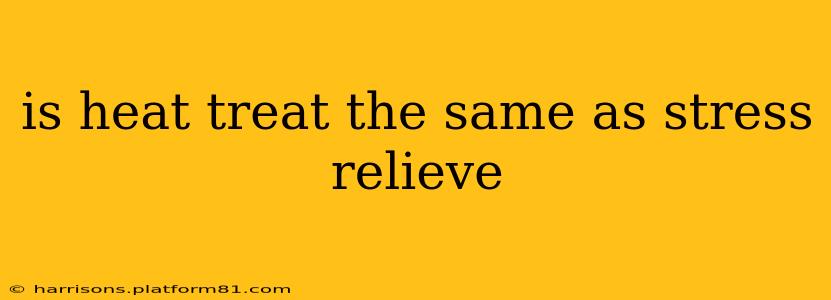Is Heat Treat the Same as Stress Relieve? Understanding the Differences
While both heat treating and stress relieving involve heating and cooling metal, they are distinct processes with different goals. They are often confused, but understanding their differences is crucial for selecting the right process for your application. This article will clarify the distinction between these two important metallurgical processes, addressing common questions along the way.
What is Heat Treating?
Heat treating is a broad term encompassing various techniques used to alter a metal's physical properties, such as hardness, strength, ductility, and machinability. These techniques involve precisely controlled heating and cooling cycles. The goal is to improve the metal's overall performance characteristics to meet specific design requirements. Common heat treating methods include:
- Annealing: Softening the metal to improve machinability.
- Hardening: Increasing hardness and strength.
- Tempering: Reducing brittleness after hardening.
- Normalizing: Refining the grain structure for improved properties.
What is Stress Relieving?
Stress relieving, on the other hand, focuses specifically on reducing residual stresses within a metal component. These stresses can arise from various manufacturing processes like welding, machining, or casting. Residual stresses can cause warping, cracking, or premature failure over time. Stress relieving aims to minimize these stresses without significantly altering the metal's other properties. The process typically involves heating the metal to a specific temperature, holding it for a period, and then slowly cooling it.
Key Differences: Heat Treating vs. Stress Relieving
The primary difference lies in their objectives:
- Heat Treating: Aims to change the material's microstructure and overall properties.
- Stress Relieving: Aims to reduce internal stresses without drastically changing the material's properties.
Stress relieving is often part of a broader heat treating process, but it isn't the same thing. Think of it as a specific step within a larger procedure.
Frequently Asked Questions (PAA)
Here are some common questions related to heat treating and stress relieving, addressed to provide a comprehensive understanding:
1. What are the different types of heat treatments?
As mentioned above, heat treatments encompass several techniques like annealing, hardening, tempering, and normalizing. Each method achieves different results based on the heating and cooling cycle and the specific material being treated. The choice depends entirely on the desired outcome.
2. Does stress relieving change the hardness of the metal?
Ideally, stress relieving shouldn't significantly change the hardness of the metal. The goal is to reduce internal stresses, not to alter the material's strength or hardness. However, slight changes might occur depending on the specific process and material.
3. What temperature is used for stress relieving?
The temperature used for stress relieving varies greatly depending on the metal's type and composition. Generally, it's a lower temperature than those used for other heat treatments like hardening. It's crucial to consult material-specific guidelines to determine the appropriate temperature.
4. How long does stress relieving take?
The duration of stress relieving depends on factors such as the metal's thickness and the desired level of stress reduction. Thicker parts require longer holding times at the specified temperature.
5. What are the benefits of stress relieving?
The main benefits include increased dimensional stability, reduced risk of cracking, improved fatigue life, and enhanced overall component lifespan. By mitigating residual stresses, stress relieving helps to improve the reliability and longevity of the finished product.
6. Is stress relieving necessary for all metal parts?
Not all metal parts require stress relieving. The need depends on factors such as the manufacturing process, the part's geometry, and the material used. Parts with high residual stresses resulting from welding or machining are more likely to benefit from stress relieving.
Conclusion:
Heat treating and stress relieving are distinct yet related metallurgical processes. While stress relieving can be considered a component of heat treating in some cases, their primary aims differ. Understanding these differences is crucial for selecting the appropriate process to ensure the desired mechanical properties and longevity of a metal component. Consult a materials specialist or engineering handbook for material-specific guidelines on heat treatment and stress-relieving procedures.
